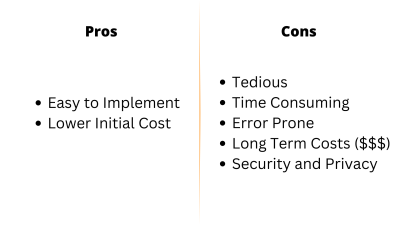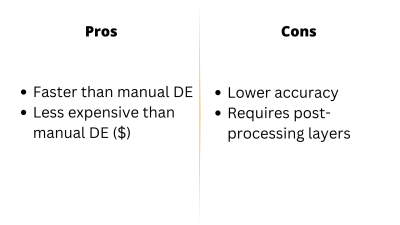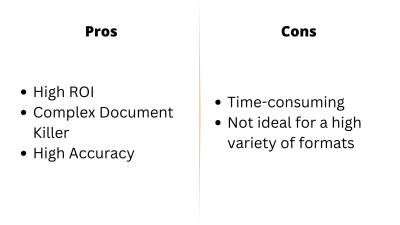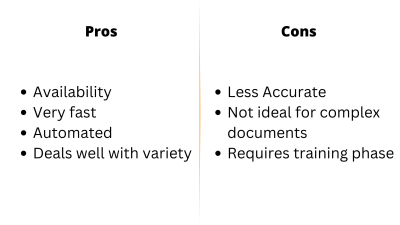
Streamlining Healthcare Operations with Automated Data Entry
Data entry in healthcare is extremely common for one major reason: the number of documents – patient information, medical records, insurance forms, billing forms, lab reports, prescriptions, consent forms, and medical charts, and that’s just the beginning.
Undoubtedly, data entry in healthcare is important because it is crucial for delivering great patient care, driving accurate and useful research, and complying with healthcare regulations. For the same reason, it is also vital that data is entered in a timely manner.
AI-Based Data Extraction can help healthcare providers to streamline their workflow and provide better and more efficient patient care. In this article, we will explore how AI-Based Data extraction can help hospitals and clinics to automate data entry. We will discuss in detail the benefits it offers and the potential challenges and limitations that need to be considered.
Data Entry in Healthcare: The Four Data Extraction Methods
There are four ways in which businesses extract unstructured data from business documents. These are:
- Manual Data Entry: Manual data entry is the traditional method for extracting data. However, it is not the most efficient. This process involves manually retrieving specific information from a source document and inputting it into a target program.

- Optical Character Recognition: The next method on the list is an approach that has been around for decades, known as Optical Character Recognition (OCR). This technology converts images and handwritten text into machine-readable patterns of 0s and 1s to identify alphanumeric characters.

- Pattern Recognition: Another alternative is pattern recognition – an approach that has been in use for much longer than OCR and computer vision. This method is relatively quick and simple, and offers a high ROI compared to other solutions.

- AI-Based Data Extraction: Another alternative is AI-Based Data extraction, which uses purely AI-based extraction methods that utilize machine learning techniques like NLP and CNNs. These solutions are gaining popularity due to their availability, speed, and ability to produce good results with simpler document formats.

Pattern recognition is currently the most popular method for extracting data from unstructured and semi-structured documents due to its convenience, usability, and customizability. However, it needs to improve on reducing the time taken to create template schema on documents with complex and dynamic layouts to remain competitive.
An advanced approach that combines pattern recognition and AI techniques can increase process efficiency by as much as 10 folds or more. This approach has the potential to exploit the best of both computer vision’s speed and pattern recognition’s accuracy.
Benefits of Automated Data Entry in Healthcare
AI-based data extraction can bring numerous benefits to hospitals and clinics, including:
- Increased efficiency and productivity: According to this survey of 9,600 workers conducted by Asana, 62% of workdays are lost to repetitive, mundane tasks. AI-powered systems can process large volumes of documents in a fraction of the time it would take humans to do so, freeing up staff time for higher-level tasks.
- Improved accuracy and quality of data: AI-powered systems can provide an accuracy of greater than 98%. To contrast this number, manual data entry can have accuracy as low as 75%. AI can recognize and extract data more accurately and consistently than humans, reducing the risk of errors and inconsistencies in data. Automated data extraction can also help reduce variability and increase the standardization of data, improving overall data quality.
- Enhanced decision-making and patient care: Faster access to accurate and relevant patient data improves decision-making and patient outcomes, especially in critical care situations. AI-powered systems can also help identify patterns and trends in patient data, providing insights that can inform treatment plans and improve patient care. In fact, studies show that AI now diagnoses diseases better than your average doctor.
- Cost savings and revenue generation: By reducing manual labor and improving data quality, AI-based data extraction can help hospitals and clinics save costs and increase revenue. Calculate just how much you can save with this calculator!
Overall, AI-based data extraction can help hospitals and clinics to streamline their operations, reduce errors, and improve patient outcomes.
How Hospitals and Clinics Use AI-Based Data Extraction
AI-based data extraction has a wide range of use cases in the healthcare industry. Here are some of the most common ones:
- Patient Information Management: Hospitals and clinics generate a large amount of patient data every day, including patient registration forms, insurance claims, medical history, lab results, and so on. AI-based data extraction extracts this data and stores it in a central database. This makes it easily accessible to doctors and other healthcare professionals.
- Electronic Health Records (EHRs): Similarly, EHRs are digital versions of patient medical records that are easily shared among healthcare providers. AI-based data extraction is used to extract information from paper-based medical records and convert them into digital formats. Automatic extraction of patient data from medical charts and EHRs help reduce the burden on healthcare staff and improve patient care and interoperability.
- Billing and Claims Management: Processing insurance claims and billing patients is a time-consuming and error-prone task. AI-based solutions extract relevant information from invoices, receipts, and other billing documents, making the process faster and more accurate.
- Lab Reports and Diagnostic Imaging Reports: Analyzing lab reports and diagnostic imaging reports is a critical part of patient care. AI-based data extraction extracts relevant information from these reports, such as test results, and integrates them with patient records to provide a more complete picture of the patient’s health.
Implementing AI-Based Data Extraction in Hospitals and Clinics
AI-based data extraction has the potential to revolutionize the way healthcare institutions process patient data. However, implementing such a system requires careful planning and consideration of various factors, including data privacy and security.
The process of implementing AI-based data extraction in a hospital or clinic setting typically involves several steps.
First, the healthcare institution needs to assess its current document management system and identify areas that could benefit from automation. This could include tasks such as patient intake forms, insurance claims processing, and medical records management.
Secondly, once the areas for automation have been identified, the healthcare institution will need to select an AI-based data extraction solution that meets its needs. This may involve evaluating different vendors and solutions and considering factors such as accuracy, speed, and ease of use.
Thirdly, the healthcare institution will also need to ensure that its data extraction procedures comply with relevant data privacy and security regulations. This may involve obtaining consent from patients, implementing appropriate data access controls, and ensuring that the data is stored securely.
Finally, once the system has been implemented, healthcare institutions should monitor its performance and adjust as necessary. This may involve tweaking the system’s parameters to improve accuracy or provide additional training for staff.
Implementing AI-based data extraction in a hospital or clinic setting requires careful planning and consideration of various factors. By taking a strategic approach, healthcare institutions can realize the benefits of automation while ensuring that patient data remains secure and protected.
Challenges and Limitations of AI-Based Data Extraction in Hospitals and Clinics
While AI-based data extraction offers many benefits for hospitals and clinics, there are also some potential challenges and limitations that need to be considered.
- Ethical concerns: AI-based data extraction involves the processing of sensitive patient information, such as medical history, diagnoses, and treatments. Therefore, there is a risk of data breaches and unauthorized access to this information, which can have serious ethical implications. Hospitals and clinics need to ensure that they have robust data privacy and security policies in place to mitigate these risks.
- Integration with existing systems: AI-based data extraction needs to be integrated with existing hospital or clinic systems, such as electronic health records (EHRs) and patient management systems. This is a complex process and requires careful planning and coordination. The end goal is to ensure the new system is integrated with the existing infrastructure.
- Adoption by staff: AI-based data extraction requires staff to learn new tools and technologies. This is a challenge, particularly for those who are not comfortable with technology. Therefore, hospitals and clinics need to provide adequate training and support to ensure that staff can use the new system effectively.
Overall, while AI-based data extraction offers significant benefits for hospitals and clinics, these potential challenges and limitations need to be carefully considered during the planning and implementation phase.
Streamlining Healthcare Operations: A Recap
In conclusion, AI-based data extraction has the potential to revolutionize healthcare by improving efficiency, reducing costs, and enhancing patient care. By automating the process of data extraction from unstructured documents and working through the challenges of implementing such solutions, hospitals, and clinics can save time and resources while ensuring that critical information is available when and where it is needed.
Looking to the future, AI-based data extraction will continue to play an increasingly important role in healthcare. As technology continues to advance, we can expect to see further developments in AI-based data extraction techniques, including improved accuracy, greater customization, and enhanced integration with other healthcare technologies. By embracing these innovations, hospitals and clinics can continue to improve patient care while staying at the forefront of technological progress.
 Astera AI Agent Builder - First Look Coming Soon!
Astera AI Agent Builder - First Look Coming Soon!

